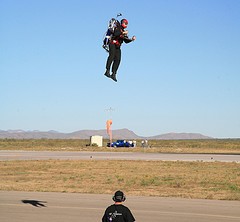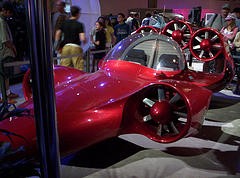5 Experimental Forms of Transport
These days the most common forms of transport we really know about are land vehicles (cars, bikes, trucks, etc.), sea vehicles (boats, jet skis, etc.) and air vehicles (planes, helicopters, etc.).
But where is the world headed in terms of transport, how far off are we from these advances forms of transport and how likely is it that any of them would ever actually work? In this blog we’re going to look at five forms of transport that are still in their experimental phases.
1. Jetpacks

Jetpacks have actually been around for a few decades, but all of them have only been test models with none of them being commercially available. One of the first successful jetpacks was actually intended to be used by the US army. While it actually worked fine, gaining impressive heights and speed, the amount of noise it caused was simply too much.
From there forms of jetpacks have existed as water powered, air pressure powered, rocket powered and even in a hovering form. But with each jetpack that has come out, its noise, danger or cost has always prevented it from being released commercially or not. But something tells us that one day jetpacks will be available – not necessarily during our time, though.
2. Solar powered vehicles
Now, solar power isn’t actually an experimental energy source, but when trying to utilise it to power vehicles such as cars, things get a little problematic. Not only is a lot of power needed to keep a vehicle moving, but so is a lot of insolation (sun radiation) exposure.
While parts of Australia get plenty of insolation year round, that doesn’t mean a country like Canada would be in the same boat. It’s because of this inconsistency in the availability of solar power’s energy source that prevents solar powered vehicles from becoming a truly viable alternative to fuel-powered or hybrid vehicles.
3. Flying cars

In the same boat as jetpacks, flying cars actually have been developed but they haven’t really reached to the look of the flying cars we see in The Jetsons, Futurama, or The Fifth Element. Instead, these cars basically look like small aircrafts. And while they do work, there are too many issues that flying cars present.
First and foremost is cost. Flying cars are no cheap purchase, considering what you’re buying – essentially a plane – and how much fuel for a flying vehicle would cost. Second of all is the fact of trying to regulate flying cars. They’re not designed with the intention of flying from country to country, but rather for the same distances we currently travel in ground-restricted cars. So how would laws to flying cars apply?
But when all is said and done, flying vehicles doesn’t seem like a far-fetched idea. In fact with the world’s population growing it could present a solution to the issue of constantly having to build new roads. Eventually we won’t be able to keep building roads, so where do you go from there? Perhaps you go to the skies.
4. Hypersonic flight
Fast commercial flight has been done before in the form of the Concorde, a supersonic passenger airliner which is no longer in operation. The Concorde was substantially faster than any other commercial aircraft now available, reaching speeds of around Mach 2. An average flight between New York, USA and London, England takes around 8 hours. The Concorde once completed this flight in 2 hours and 53 minutes.
Now hypersonic flight is a possibility, with a number of airlines interested in the technology. But will it be faster than the Concorde and its supersonic flight speeds? Well, as we said, Concorde typically flew at around Mach 2. Hypersonic flight can reach Mach 5.5. So yes, it will be faster. This technology is still off for a bit though, with commercial availability not predicted until at least 2050.
5. Space travel

Decades ago we were being told we’d be taking frequent visits to the moon and maybe even starting colonies on their by the year 2000. Suffice to say, those predictions were a bit off, but space travel is now becoming something some big airline companies are interested in – in particular Virgin.
Virgin Galactic will take people out of the atmosphere into suborbital space where they will experience approximately 7 – 8 minutes of weightlessness while being able to look back down at earth. Eventually Virgin hopes to offer complete spaceflights that will last far longer and go a bit deeper into space. Virgin Galactic flights have not happened yet and they’re certainly expensive, with a ticket per person costing almost $200,000. Then again, how often do you get to say you’ve been to space?
There’s no real knowing when space travel will become a common thing, but we’d say it’s still a fair way off, unless we all become multi-millionaires.
Have any other forms of experimental travel you want to mention? Share with us in the comments below.
* Image sources: